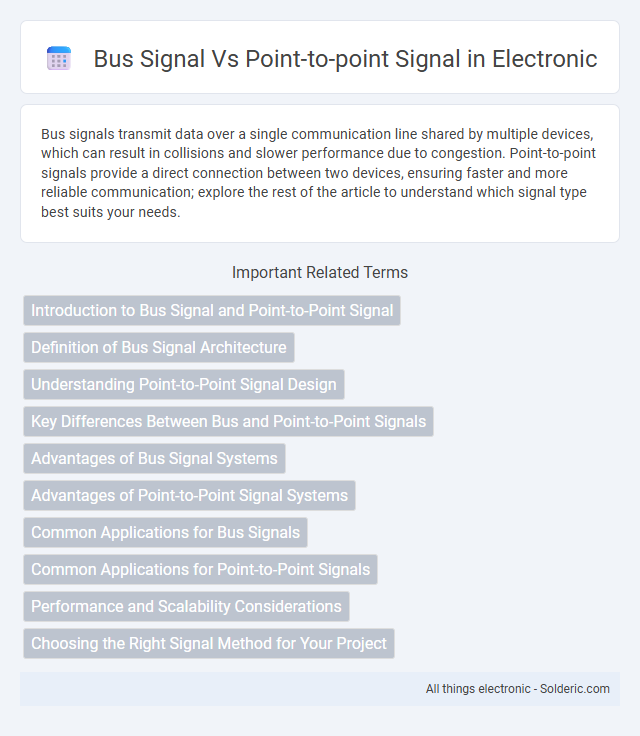Bus signals transmit data over a single communication line shared by multiple devices, which can result in collisions and slower performance due to congestion. Point-to-point signals provide a direct connection between two devices, ensuring faster and more reliable communication; explore the rest of the article to understand which signal type best suits your needs.
Comparison Table
| Aspect | Bus Signal | Point-to-Point Signal |
|---|---|---|
| Definition | Multiple devices share a common communication line | Direct connection between two devices |
| Data Transmission | Sequential or parallel sharing on a single bus | Dedicated transmission channel |
| Complexity | Lower wiring complexity, scalable for multiple devices | Higher wiring complexity as each pair requires separate lines |
| Signal Integrity | Prone to noise and interference due to shared medium | Improved signal quality and reduced noise |
| Speed | Limited by bus contention and arbitration | Higher speed possible with dedicated paths |
| Cost | Generally lower due to shared medium | Higher due to additional wiring and connectors |
| Scalability | Good for moderate number of devices | Less scalable, complexity increases with more devices |
| Use Cases | Common in legacy systems, multiplexed communications | Preferred in high-speed, point-to-point communication (e.g., PCIe) |
Introduction to Bus Signal and Point-to-Point Signal
Bus signals aggregate multiple data lines into a single communication pathway, enabling simultaneous transmission of several bits and optimizing hardware resource usage. Point-to-point signals establish a dedicated one-to-one connection between devices, ensuring higher signal integrity and reduced interference for critical data transfers. Your choice between bus and point-to-point signaling impacts system performance, scalability, and complexity in digital communication designs.
Definition of Bus Signal Architecture
Bus signal architecture refers to a communication system where multiple devices share a single set of signal lines to transmit data sequentially or simultaneously. This design reduces the number of wiring connections compared to point-to-point signaling, where each device pair has a dedicated communication path. Bus signals enable efficient data transfer and resource sharing in complex electronic systems, such as computer motherboards and industrial networks.
Understanding Point-to-Point Signal Design
Point-to-point signal design involves a dedicated communication path between two devices, ensuring minimal signal interference and high data integrity. Unlike bus signaling, where multiple devices share a common line causing potential data collisions, point-to-point signals provide a direct link that enhances communication speed and reliability. Your system benefits from simplified troubleshooting and improved performance through the clear data transmission inherent in point-to-point architectures.
Key Differences Between Bus and Point-to-Point Signals
Bus signals enable multiple devices to share a common communication line, optimizing wiring complexity and cost, while point-to-point signals provide dedicated connections between devices for higher signal integrity and faster data transfer. Bus architectures are typically used in systems where scalability and reduced wiring are priorities, whereas point-to-point connections are favored in high-speed applications requiring minimal interference and latency. Understanding these differences helps you select the right communication method to balance efficiency, speed, and system complexity.
Advantages of Bus Signal Systems
Bus signal systems offer significant advantages such as reduced wiring complexity and cost by aggregating multiple signals onto a single communication line. This shared pathway enhances scalability, making it easier to add or remove devices without extensive reconfiguration. Bus architectures also improve data synchronization across components, ensuring consistent signal timing and reducing latency in integrated circuit designs.
Advantages of Point-to-Point Signal Systems
Point-to-point signal systems offer significant advantages such as reduced signal interference and improved data integrity by dedicating a unique communication line between devices. These systems often provide higher data transfer speeds and enhanced reliability compared to bus signal systems, which share a common communication medium. Your network will benefit from easier troubleshooting and scalability when using point-to-point connections, ensuring optimal performance in complex applications.
Common Applications for Bus Signals
Bus signals are widely used in computer architectures for data transfer between multiple components like CPU, memory, and I/O devices due to their efficient handling of parallel data paths. Common applications include system buses such as the PCIe and USB interfaces, where multiple devices share a communication medium to streamline data exchange. This design is critical in embedded systems and networking hardware to reduce wiring complexity and improve scalability.
Common Applications for Point-to-Point Signals
Point-to-point signals are widely used in high-speed communication interfaces such as PCI Express, SATA, and USB, where dedicated, direct connections between devices minimize latency and maximize data throughput. These signals are preferred in applications requiring secure and reliable data transfers over short distances, including chip-to-chip communication on printed circuit boards (PCBs) and inter-processor links within computing systems. The direct wiring minimizes interference and crosstalk, making point-to-point signaling ideal for real-time control systems and high-frequency trading platforms demanding low jitter and deterministic timing.
Performance and Scalability Considerations
Bus signals offer simplicity and lower wiring complexity, making them suitable for systems with moderate performance requirements and limited scalability. Point-to-point signals provide higher data transfer rates and reduced latency by establishing dedicated connections, which significantly enhance performance and support greater scalability in complex or high-speed systems. Your choice should consider the trade-off between the cost of wiring complexity and the performance needs of your application.
Choosing the Right Signal Method for Your Project
Bus signals efficiently connect multiple devices along a shared communication line, ideal for complex systems requiring synchronized data exchange, while point-to-point signals offer direct, dedicated connections that minimize interference and maximize data integrity. Your choice depends on factors such as system complexity, data rate requirements, and physical layout constraints, with bus signals suited for scalability and point-to-point signals favored in high-speed, low-latency applications. Optimizing signal methods enhances overall performance and reliability in your project's communication network.
bus signal vs point-to-point signal Infographic

 solderic.com
solderic.com